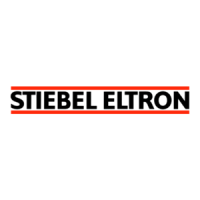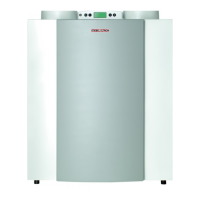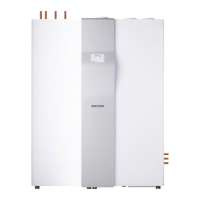18
26_04_01_0113
2.3.2 Function
Air is supplied by the extractor fan (1) and
channelled outside via the evaporator (14).
The energy made available by the heat pump
during this process is transferred to the
DHW or central heating system via separate
condensers (4 and 10).
When the heating system demands lots of
energy at low outside temperatures, the
additional energy required is supplied by the
electrical booster (3).
When there is a high DHW demand, the DHW
is heated by an electric immersion heater (8).
2.3 Equipment description
2.3.1 Function diagram
1 Extract fan
2 Compressor
3 Electric booster (heating)
4 Condenser - heating
5 Circulation pump
6 Diverter valves
7 Non-return valve
8 Electric immersion heater (DHW)
9 Heat exchanger/indirect coil
10 Condenser - DHW
11 DHW cylinder
12 Non-return valve
13 Common dryer
14 Evaporator
15 Expansion valve
16 Non-return valve
I Extract air
II Expelled air
III Expelled air (optional)
IV Hot water
V DHW circulation
VI Cold water
2.4 Instructions and regulations
On the water side:
DIN 4751 sh. 1 and 2: Safety equipment for hot
water heating systems
DIN 1988: Technical rules for DHW installations
TRD 721: Safety equipment to prevent excess
pressure - safety valves, or local regulations.
On the electrical side:
DIN VDE 0100: Regulations for the installation
of HV systems with rated voltages up to
1000 V.
VDE 0701: Regulations regarding the repair,
modification and testing of used electrical
equipment.
TAB: Technical connection conditions for
connections to the LV mains.
On the refrigerant side:
EN 378: Safety and environmental
requirements, or local regulations.
On the air side:
DIN 1946 T1, T2, T6 - Ventilation and air
conditioning
DIN 2088 - Domestic ventilation equipment
VDI 2087 - Air ducts
General:
Collation of technical requirements for boiler
rooms, e.g. Boiler Room Directives or national/
local Building Regulations, commercial and
fire as well as emission control regulations
and requirements, or local regulations.
TA-Lärm: Technical instructions to protect
against noise emissions.
Fig. 5

